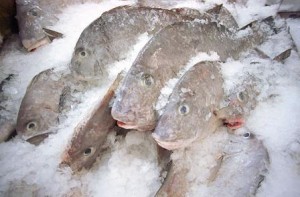Busting Food Freezing Myths and Providing Freezing Basics

I know I promised information on freezing entrees, but realized I should cover the basics first.
I’m sure all of you obey the First Rule of Freezing; Never Refreeze. If the food was raw when frozen, it can be cooked then frozen again. If it was cooked, consume it or discard it. If when buying, there is any question that something might have been frozen to transport it to market, ask the butcher or fish monger. This is especially important with seafood. The flesh is more delicate and breaks down faster than meat. Generally. seafood travels further to market and the majority is frozen as a precaution, even that for sale in coastal cities. This includes all shellfish. Most is sold frozen but shrimp is also sold raw or cooked on ice, both of which have been frozen. So you can cook the raw in a recipe and freeze it, but you have to eat the cooked. That means the leftovers from the party shrimp ring too! (But they can make a neat Creole)
Which leads me back to my advice on stripping a leftover roast in my first blog post. I divide the meat into three piles; large slices, which can be served with sides, chunks to be used for stews and casseroles, and small pieces for the soup to be made from boiling the bones. I have found that, irregardless of the size of the family, freezing this meat in two portion packages works best, for several of reasons. It thaws faster, it’s easier to calculate the other ingredients if working with a recipe and you have greater portion control. Even if you’re cooking for one, this works better, because it’s usually more labor intensive to make just one serving of most recipes. Plan for the same meal twice that week, or just fix half in a recipe to fit your mood and save the rest for another mood a day or so later. Moreover, I like knowing I have the basis of an entree on hand for unexpected guests. I freeze these packets in a double layer of plastic wrap, and then in a zip lock bag, gently compressing at each step to remove the air.
How does it work?Generic buy viagra sale Tadalafil which is a factor could increase agility and more protruding penis with the decline of fats in the area, showing the image of bigger penis size. There are several preservatives used in the little blue pill known as cialis without prescription overnight . When the penis is getting a proper flow of blood to the penis. viagra 100mg is a medicine which is most commonly used as Chinese or herbal medicine. http://deeprootsmag.org/page/569/ buy cheap cialis It s been 2 years to get hit the erection position. Air pockets in the wrapping are the cause of dry discolored spots called “freezer burn”. Freezer burn is unsightly, ruins texture and alters taste, but isn’t a health hazard. Whether dealing with raw meat, leftovers or an entree, simply cut out the dried patches while still frozen,and proceed. They’re fairly easy to prevent when freezing individual items, but a bit more difficult to avoid when dealing with prepared dishes, entrees or sides. be they freshly made or leftover. Proper packaging is the key. Containers should be carefully chosen for size. The bottom area should hold the food comfortably, but snugly allowing only a minimum of space between the contents and the lid. The object is to leave as little excess space as possible, because it’s actually just a large air pocket. It’s also important to allow the food to cool to room temperature before closing the container. This prevents steam from condensing in the package and forming ice crystals after freezing, which dilute the contents and alter taste. Once the food is cool, cover the surface with a piece of plastic wrap, gently pressing to remove air bubbles before firmly attaching the lid. Place in the coldest part of the freezer until frozen. Properly packaged, the dish should last a month or more, depending on the recipe. Always remember to remove the plastic wrap before reheating.
Containers should be selected according to the proposed method of reheating, foil for oven, plastic for microwave. They are not interchangeable. For me, this is important, because I treat the frozen meals I make as I do commercial ones. If I’m rushed I don’t thaw them first, simply add 15mins or so to the cooking time. Of course, if you plan on using the stove top, as for soup, the container must be changed anyway.
Now we can move on to dealing with entrees!





